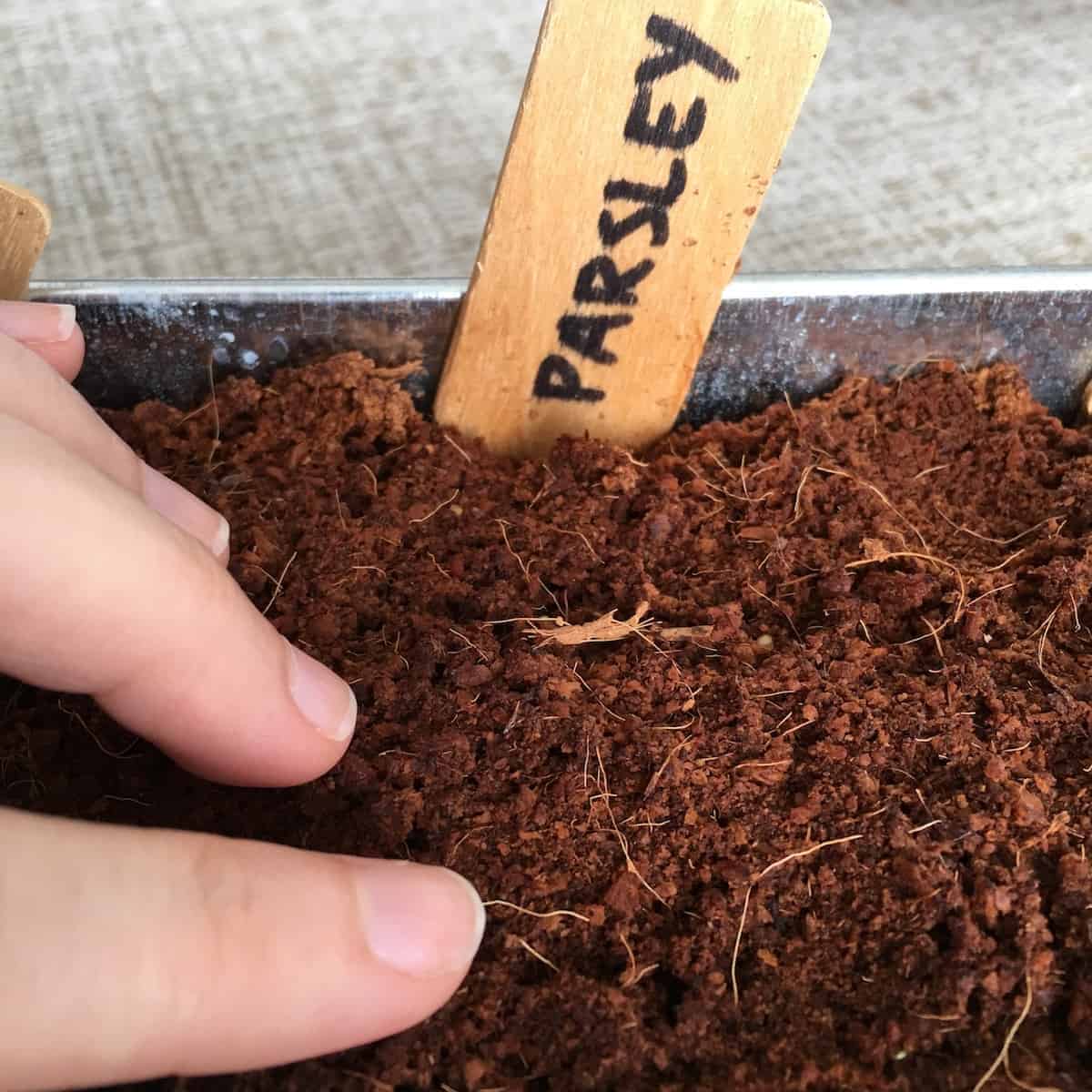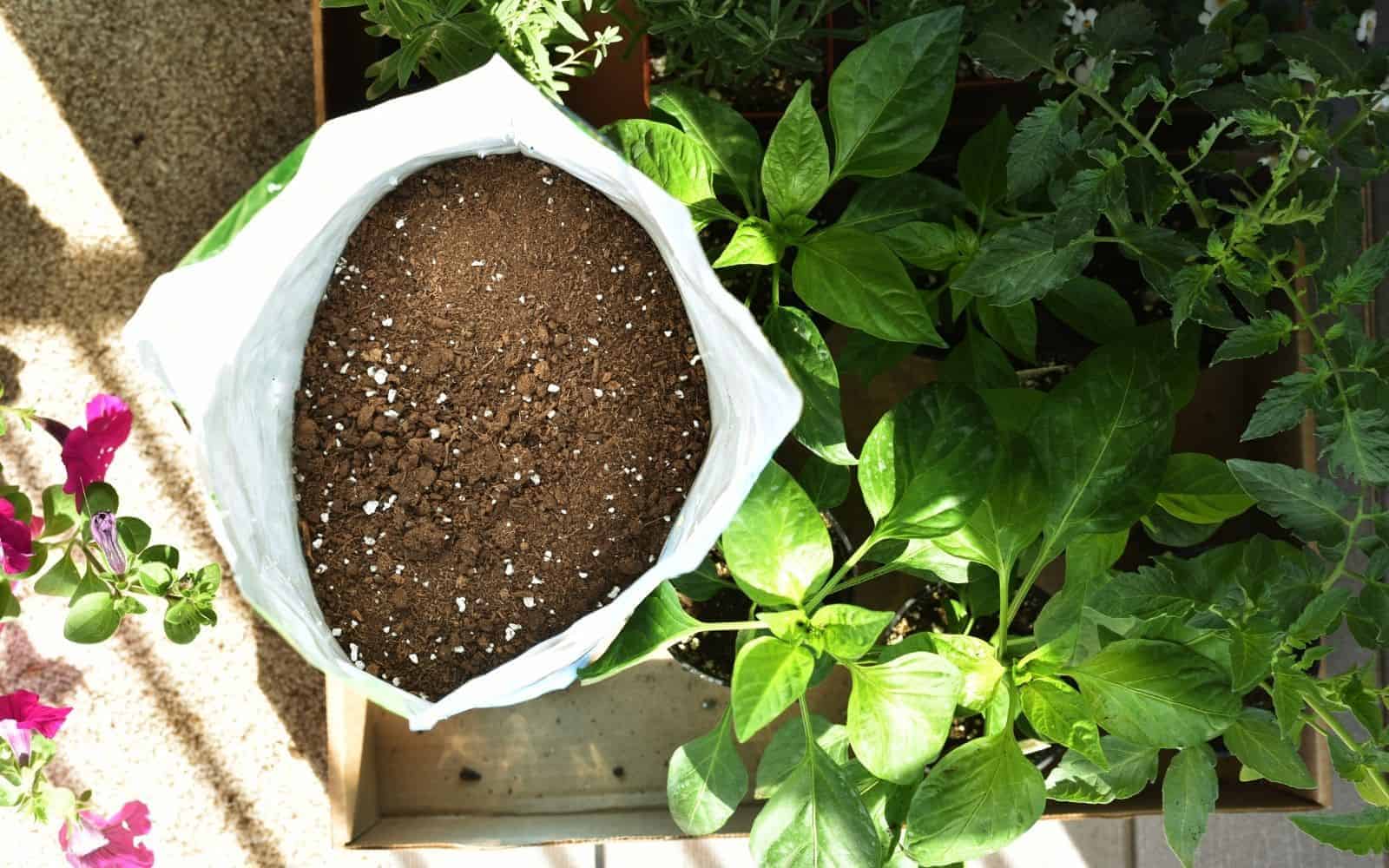There are countless options for potting mix, but many of the most eco-friendly potting soil products contain coco coir. There are lots of reasons to use this growing medium in both container gardening and other growing applications.
Coco coir is a growing medium made from the fibers of coconut husk. The loose, clean fibers help the potting mix retain enough water for plant roots while also allowing excess water to drain away. Coco coir offers excellent aeration and provides a “blank slate” environment. Many sustainable potting soil mixes include coco coir, as coconut husk is a renewable resource that may otherwise be treated as a waste product.
Read on to learn all about using coco coir in the garden!

Coco coir: The basics
Coco coir is the dried husk fibers from the outer husk of the coconut. The coconut husk is chipped and sometimes shredded to produce a loose fiber. The type of coir used in gardening and horticulture is brown coco coir. All this means is that it is from a ripe coconut instead of an unripe coconut. Coco coir is a top choice for both gardeners and hydroponic farmers. This is because of the rare and desirable qualities that coco coir brings to the table as a growing medium.
There are three main reasons coco coir is good for growing plants: it has excellent water retention, it aids in soil drainage, and it encourages soil aeration. Coco coir fibre provides a stable growing medium for the roots, allowing for both air and water to coexist in the root zone (vital for plant growth).
Coco coir can be used on its own for starting seedlings or as a growing medium in a hydroponic system in which nutrients are added to the water. Since coco coir does not contain most of the nutrients growing plants need, fertilizer is added so the plants can develop properly.
Coco coir is most commonly mixed with other growing mediums to create a high-quality potting mix. Coco coir is generally combined with perlite, peat moss, organic compost, worm castings, biochar, and other materials to create a potting mix for growing plants in containers. Coconut soil can be customized to grow different types of plants, such as orchids or succulents.
Coco coir can also be mixed with soil to create an outdoor potting mix. Some gardeners choose to mix their outdoor soil with coco coir, not only in the ground but more commonly in their raised garden beds. Coco coir can help improve the existing soil by adding bulk while still allowing for drainage. Unless a gardener has naturally sandy loam soil, improving the soil with coco coir may well produce a better growing area than the soil alone.

Buying coco coir for gardening
Here are some garden centers that offer coco coir for gardening:
- EarthEasy Coco Coir Brick (11 Pounds, Makes 16-20 Gallons), Made in USA
- ViaGrow Coco Coir Brick (11 Pounds, Makes up to 18 Gallons), at Home Depot
- ViaGrow Fluffed Loose Coco Coir (1.5 Cubic Feet), at Home Depot
- Mountain Valley Coco Coir Disks (Makes 4.25 Gallons), at Walmart
“Most ready-made mixes are a blend of composted tree bark, peat moss or coconut coir (made of composted coconut fibre), organic fertilizers, and drainage grit such as pumice or sand. These mixes are light and easy to use.”
Sunset Outdoor Design & Build: Container Gardening: Fresh Ideas for Outdoor Living, by Hank Jenkins & The Editors of Sunset Magazine
How to use coco coir?
Coconut Coir is often compressed into bricks for easy handling and storage. Adding water causes the coir to expand in size. Soak coir brick in water for 1 hour before using. Most retail-sized bricks expand to 16-20 gallons.
To use coconut coir as a growing medium, mix with topsoil and add compost to provide organic nutrients. For garden beds, add one part coir to two parts topsoil. For containers and potted plants, add one part coir to two parts soil or potting mix.
Coir is great on its own for starting seeds and cuttings because it maintains a consistent level of moisture and it is naturally weed-free and disease resistant.
Coco coir can also be used as a soil amendment to improve outdoor in-ground soil. When used in sandy soils, coir helps keep nutrients and moisture close to roots instead of leaching away. When used in clay soils, coir breaks up hard compacted soil, so nutrients and moisture move through the soil.
Coir is sometimes used in compost tumblers or worm bins. Coir fiber is carbon-rich and used to balance nitrogen-rich materials such as kitchen scraps and grass clippings in the compost pile. In general, add two parts coir to one part green organic material.

Types of coco coir sold
Before coco coir is sold, it normally needs to be treated in order to remove any salts. After coir is treated, it is normally sold in one of three forms: brick, loose, and potting mix. It should be noted that coco coir on its own isn’t usually used for gardening (except seed starting) – it’s generally mixed with other potting medium ingredients such as perlite.
Coco coir bricks
Coco coir bricks are compressed masses of coir (see image above). These tend to be about the size of a normal construction brick or yoga block, but can be bigger or smaller depending on the brand. These expand greatly when wet and they can grow up to nine times their size! But, how big they grow depends on how compressed the coir has been, which also depends on the brand. So, check the label to see the final prepared volume.
With that in mind, it does need to be said that in order to use these bricks for gardening, they do need to be saturated with water. This is how they expand and become useful. How much water depends on how big the brick is. Small bricks can be saturated in a bucket until they are hydrated, while larger bricks may require a wheelbarrow for hydration.
After it is wet, there are a few things you can do. As it is, coir is good for starting out seeds. Coco coir provides a great environment for seeding because it is constantly moist. The seeds won’t grow much beyond sprouts if they’re planted just in coir, so make sure that you bed them in soil pretty soon after they sprout. This is because coco coir does not contain the mineral nutrients the plants need after they reach the baby seedling stage.
You can also add coir to compost to change the soil qualities. Adding coir will help in the big three areas that we’ve mentioned before: aeration, water retention, and soil drainage.
Coir is also good for worm beds. Just get it wet and add worms. You’ll need to give the worms more to eat than just the coco coir. They won’t live very long in just the coir, but if you add nutrients for the worms to eat, the coco coir makes a fabulous worm bed.
Lastly, use it for growing on its own. If you plant something just in coco coir and hope for it to grow, you’re going to be disappointed. Coco coir is generally considered inert. The only real nutrients it contains are sodium and potassium. That’s not enough to grow most plants – you’ll need to add a balanced organic fertilizer. This is why hydroponic farmers like to use it. It gives them almost complete control over what nutrients are going to their plants.
Using loose coco coir
The loose version of coco coir is essentially the same as the brick, but it doesn’t need to be watered as much. It is good practice to water any soil or soil mix you buy, but since this isn’t a brick, it doesn’t need nearly as much.
Another thing worth mentioning about the loose coco coir is that you need to read labels. Loose coir is likely to be mixed with something else. So make sure you know what it is you’re buying because it may not be pure coir.

Using coco coir in potting mix with perlite
Speaking of being mixed with something else, let’s talk about the perlite/coco coir mix for potting soil. We’ve talked about what coco coir is, so let’s make sure we know what perlite is before we start.
Perlite is known as volcanic rock popcorn. It’s a very hard, yet very light substance and it’s porous and cheap. What all this means is that perlite is a common resource often used in gardening. It is great at aerating and increasing soil drainage. It also helps retain some water, although this isn’t its main function. It’s not great at water retention, but it does help a little. Pure perlite is great for rooting cuttings and is commonly used in hydroponics.
Many people like to take perlite and mix it with coco coir. They get a cheaper alternative that functions nearly exactly the same as a pure form of either. The perlite will help keep the coco coir from compressing back down. The coco coir will help with water retention. Make sure that you add the proper nutrients to any plants you pot in this stuff.

Benefits of coco coir in gardening
Now, let’s talk about why you ought to use coco coir in gardening. We’ll go into depth on the big three things you want your soil to have. Aeration, water retention, and soil drainage.
Coconut coir conserves water, improves soil structure, and helps plants access nutrients held in solution. Plants will develop stronger root systems, helping them be more resistant to disease, pests, and competing weeds. Coco coir is a natural bug and fungi repellant. Its lack of nutrients gives the gardener greater control over how to grow their plants, and its reusable nature offers an economical way to get the most out of what you buy. It is a naturally-sourced renewable resource.
Soil aeration
Aeration is the property that describes how well oxygen can get to the nutrients around the root system and to the root system itself. Now, this is important. Your plants do need oxygen and so do the nutrients around them. So real quick, let’s make sure the importance of aeration in your soil makes sense and talk about plant respiration.
While plants produce their own oxygen through photosynthesis in their leaves, the root systems require access to oxygen for aerobic respiration. For the nutrients surrounding the root system, oxygen allows for other elements to be absorbed more readily into the plant root system. It also helps the microbes break down any complex nutrients into simpler nutrients, making it easier for the plant to absorb them.
In short, coco coir and other soil amendments that improve soil aeration are excellent way to help plants breathe and function better.

Water retention
Now, the ideas of water retention and soil drainage may seem like competing ideas. Don’t worry, we’ll explain why both aren’t only possible, but also important to get right.
Water retention is how long the soil retains moisture after it is wet. It is important because water is used in both photosynthesis and plant respiration. In other words, no matter what, plants require a constant supply of water to live.
Coco coir acts like a wrung-out sponge. It holds water for a long time but still holds air in its void space. This is why coco coir is so sought after by gardeners.

Soil drainage
Soil drainage is important because it acts as a sort of regulator between aeration and water retention. If the soil is full of too much air, it is dry and plants can’t survive long. If the soil gets too much water, the root system can’t access oxygen and dies, and it ends up looking like the picture above. This is why soil drainage is so important. It plays a key role in determining what kind of plants will grow in the environment it provides.
Coco coir is a good regulator of soil drainage. When it is loose and mixed in with soil, it helps keep the soil light and fluffy. This keeps a nice balance of aeration and water retention. The soil should hold enough water to support plant life, but also hold enough air to support the plants as well. The air pockets in the soil allow excess water to find paths to drain out of the soil.
To sum up, coco coir is great at regulating all of the three big concerns of a gardener’s soil. Aeration, water retention, and soil drainage.

Drawbacks of coco coir in potting mix
For all of the coco coir’s good qualities, it does have a share of drawbacks. One of the biggest downsides is the price. Coco coir can get pretty expensive pretty fast. It is better when mixed with something like perlite.
Coco coir alone in the potting mix won’t grow anything. If you are using coco coir for potting soil, you have to be sure to either mix it with good compost or add the nutrients that your plant needs.
Another thing to note is that coco coir may absorb some nutrients from the surrounding area. This isn’t necessarily a problem, but it may pose a danger to your plants. So, if you are using coconut coir, keep an eye on your plants for signs of distress. You may need to add more nutrients to your soil to compensate for the absorption caused by the coco coir.
Lastly, coco coir is sometimes naturally high in salts, particularly if it has been processed in seawater. Generally, coco coir is rinsed and cleaned prior to the sale so that it is as sterile and free of any salts and nutrients as possible. That said, not all brands of coco coir process their product the same way, and some brands may contain high levels of salts that could potentially harm plants.

Coco coir vs. Peat moss
Coco coir and peat moss have very little difference when you look at what they can do in a potting mix. They act very similarly most of the time. So, when comparing the two, you aren’t comparing what they can do; instead, you are comparing outside factors, like renewability.
Speaking of renewability, here is a good argument: Peat moss, though technically renewable, can take decades to grow. It is harvested from bogs that are traditionally slow-moving environments. This has created a hot debate about which one gardener should be using. When you compare the possible decades of regrowth that peat moss needs to the speed that coconuts can be produced, it seems almost like a no-brainer. A single coconut palm normally produces 20-70 fruit every year. This makes it much more usable in the long run than peat moss.
However, peat moss is collected in a way that is considered sustainable in some countries. Another thing to note is that peat moss has been known to trap water in soils. This is the opposite of good soil drainage. It also has a slight acidity. On the other hand, coco coir has been known to have high concentrations of sodium and potassium. Coco coir is usually treated to remove harmful salt levels.

What makes coco coir more desirable in the potting mix than peat moss is its ability to rehydrate. Peat-based potting soil that gets overly dry tends to become “hydrophobic”, repelling water. Peat moss soils tend to shrink and form a water-resistant crust that causes water to run off (often down the inside of a planter). Coir-based potting mixes are generally faster to rehydrate after periods of dryness, aiding plant recovery from drought.
All of these together basically leave you scratching your head as to which one is better. That depends on who you ask. Most gardeners now advocate the use of coco coir because it is renewable in the short term, and also because peat bogs are important carbon sinks for the atmosphere. After all, one coconut palm producing 20-70 coconuts for roughly eighty years seems like a pretty good deal! Fair Trade coco coir is recommended if buying from abroad, as coir is sometimes produced in regions that may not have adequate worker protections and equitable pay.
So now that you’ve learned all about coco coir, its benefits and drawbacks, and how it compares to peat moss, now it’s time for you to try it out yourself! You may never stop using it once you start.






